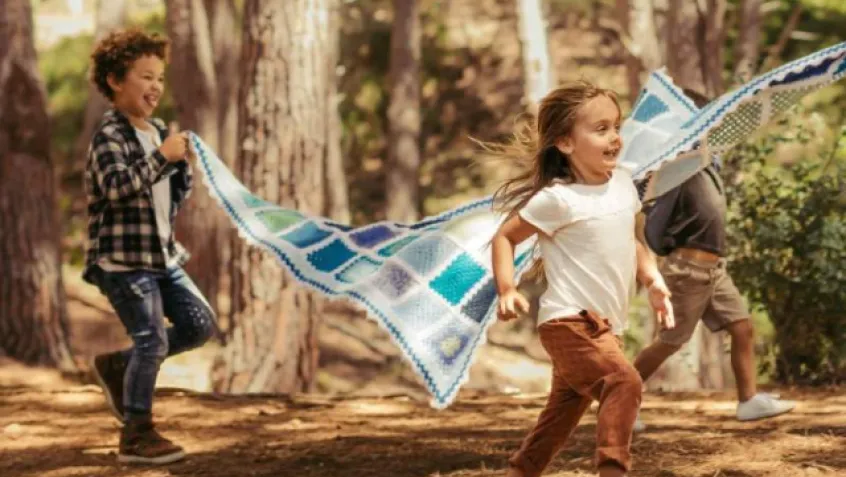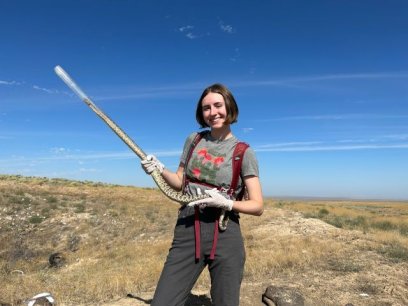
Lack of interest is the number one reason why American children, adolescents, and young adults do not participate in outdoor activities, according to the Outdoor Foundation’s 2022 Outdoor Participation Trends Report.* If you were introduced to the outdoors as a child and enjoy spending time outside, the idea that someone wouldn’t want to spend time exploring the outside world may seem hard to believe.
What could be more interesting for a young child than overturning rocks in a creek while searching for crayfish or exploring the open spaces near their community? Exposure to the outdoors plays a critical role in fostering learners that appreciate and care about the environment. Through the Wilderness Classroom, my husband, Dave Freeman, and I strive to increase students’ interest in the outdoors, and help teachers foster connections between the topics and places their students are studying with experts and explorers in the field. We have paddled the Amazon River, kayaked around Lake Superior, and traversed North America by kayak, canoe, and dogsled in order to teach kids about these places and motivate them to get out and see the natural world.
The Wilderness Classroom started with a simple idea: to improve students’ core academic skills and appreciation for the environment by introducing elementary and middle school students to the wonders of exploration and wilderness travel. Fourteen years and over a dozen expeditions later, the Wilderness Classroom is a 501(c)3 that reaches over 2,700 teachers and 85,000 students around the globe.
Using Creativity to Get Students Interested in the Outdoors
Given the impracticality of actually flying thousands of third- through eighth-grade students to remote places, we go to great lengths to make the Wilderness Classroom interactive and fun. Every Monday during a “Learning Adventure,” we use a cellular hotspot or a satellite terminal to post a “Notes From the Trail” update to the Wilderness Classroom website. We also post video clips, scientific data, mystery photos, and polls designed to immerse the students in the adventure and give them some control of the expedition by making key decisions for us.
Remember those old Choose Your Own Adventure books? This is what a Learning Adventure is like, except the decisions students make affect real people in the field—Dave and myself. Once students realize that they can vote to decide where we go and what we do, communicate with us, and really drive the expedition, their interest and motivation to learn grows.
We also conduct live video conferences with classrooms and in-person school presentations. When kids meet us virtually, or in person, it makes the Learning Adventures and exploration more tangible. Sure, Dave and I are National Geographic Adventurers of the Year, exploring wild places around the globe, but not that long ago we were fifth graders sitting in a classroom just like theirs. By working hard and investigating their local environment they can gain the knowledge and skills that open up a whole new world of possibilities.
Spending time in the Boundary Waters
In the fall of 2015, Dave and I began another Wilderness Classroom project, A Year in the Boundary Waters. The Boundary Waters is the largest wilderness area east of the Rocky Mountains and north of the Everglades. It is a maze of lakes and rivers, covering a million acres in Northern Minnesota. It is home to wolves, moose, eagles, bears, and a host of other animals. We traveled by canoe in the summer and dogsled in the winter as we studied a wide range of topics from watersheds and water quality to the Northern Lights and Native Americans.
The Wilderness Classroom's educational adventures are available free of charge thanks to a dedicated group of volunteers, sponsors, foundations, and private donations. We encourage all new educators to register on our website. It is free and only takes a minute! When you sign up, you will gain access to all our lesson plans and start receiving our educator newsletter so you can stay informed about upcoming learning adventures, new lesson plans, and other educational opportunities.
Find out more about the Wilderness Classroom at www.WildernessClassroom.org.
*Research links were updated in 2023


